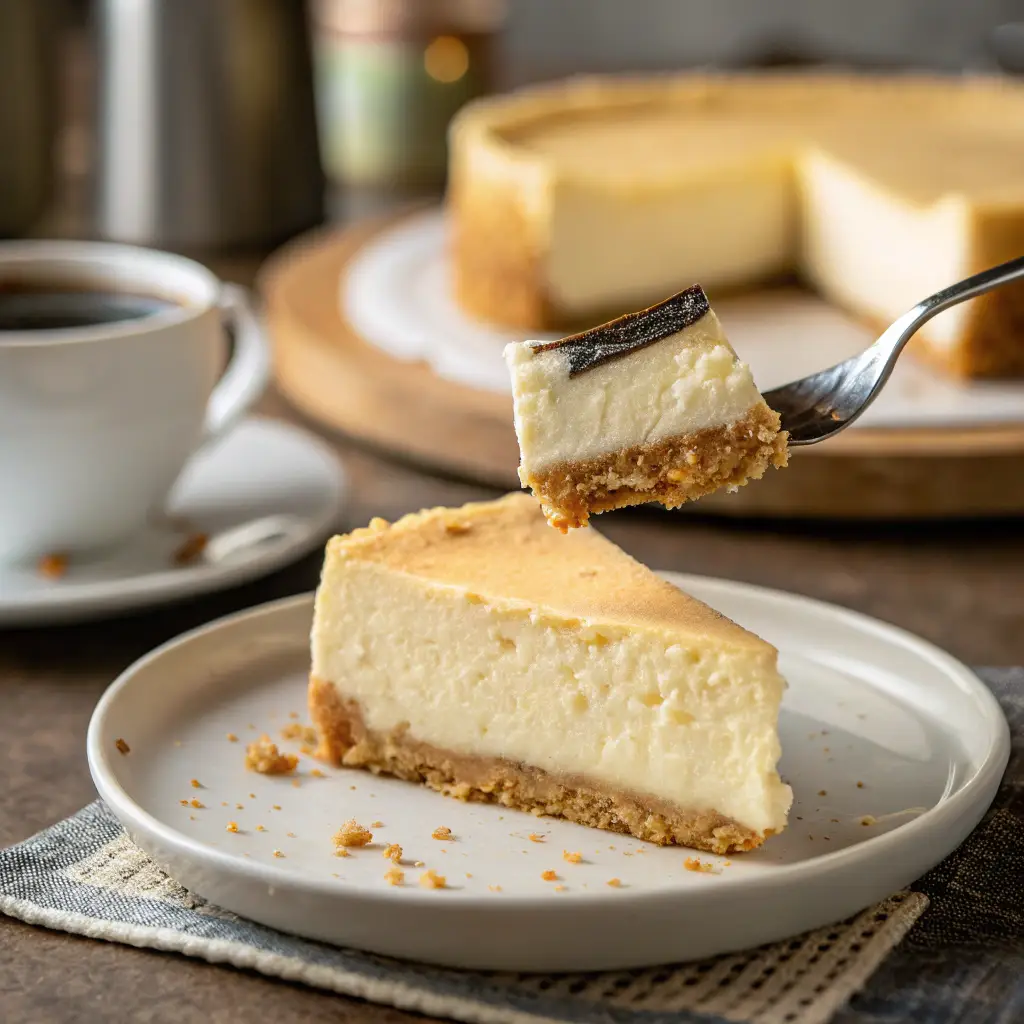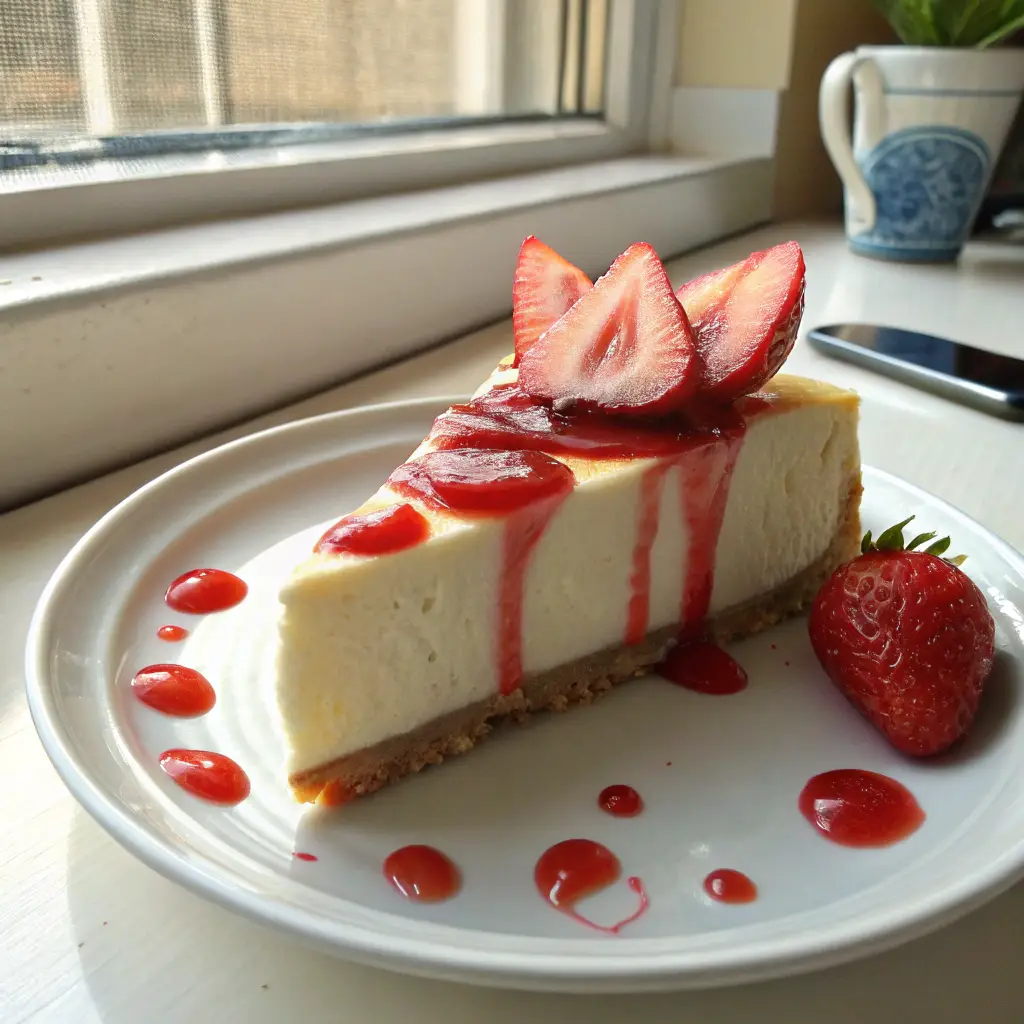What does cheesecake filling taste like? If you’ve never had a slice, you might be wondering if it’s sweet like frosting, tangy like yogurt, or rich like custard. Well, it’s all that and more! Cheesecake filling has a creamy, velvety texture with a sweet, slightly tangy flavor that melts in your mouth. Depending on the ingredients and style, the taste can range from mild and airy to rich and decadent.
In this article, we’ll break down exactly what makes cheesecake filling so irresistible. We’ll cover its flavor profile, how its texture affects the eating experience, and how different styles, toppings, and mix-ins change the taste. By the end, you’ll know exactly what to expect from this iconic dessert.
So, if you’ve ever been curious about cheesecake’s unique flavor—keep reading! 🍰
Table of Contents
Part 1: The Irresistible Allure of Cheesecake
Cheesecake is not your average dessert. It’s rich, creamy, and indulgent, with a taste that keeps people coming back for more. Whether topped with fresh fruit, drizzled with chocolate, or served plain, the cheesecake filling is what makes it unforgettable.
Why People Love Cheesecake: A Dessert Icon
People love cheesecake for different reasons—some for its buttery crust, others for its dense, smooth filling. And let’s be honest, there’s something about that first silky bite that just hits different. Unlike traditional cakes, cheesecake doesn’t rely on flour for structure. Instead, it’s made with a blend of cream cheese, sugar, and eggs, giving it that signature creamy texture.
It also has a flavor balance you won’t find in other desserts. The sweetness from sugar, the slight tang from cream cheese, and the richness from eggs and cream create an experience that’s both comforting and indulgent.
The Role of the Filling in Cheesecake’s Signature Flavor
Without the filling, cheesecake wouldn’t be… well, cheesecake. The filling is where all the magic happens. Its smooth, custard-like consistency comes from a combination of:
- Cream cheese – The star ingredient, giving it that signature tangy, rich taste.
- Sugar – Adds sweetness to balance out the tang.
- Eggs – Create a firm yet creamy texture when baked.
- Sour cream or heavy cream – Adds extra silkiness and moisture.
How Taste Perception Varies Based on Style & Ingredients
Not all cheesecakes taste the same. The filling can be thick, light, airy, or dense, depending on how it’s made:
- New York-style cheesecake – Thick, heavy, and ultra-creamy.
- No-bake cheesecake – Lighter and mousse-like.
- Japanese cheesecake – Soft, fluffy, and slightly eggy.
- Italian cheesecake – Made with ricotta, giving it a slightly grainier texture.
So, what does cheesecake filling taste like? The answer depends on how it’s made—but one thing’s for sure: it’s always delicious.
Part 2: The Flavor Profile of Cheesecake Filling – A Deep Dive
Cheesecake lovers know that its flavor isn’t one-dimensional. It’s not just sweet, not just tangy—it’s a mix of both, plus a whole lot of richness. But what exactly makes cheesecake filling taste the way it does?
What does cheesecake filling taste like? Some describe it as rich and sweet, while others highlight its slight tanginess. According to An Easy Recipes, cheesecake’s flavor is a harmonious mix of sweet, creamy, and slightly tangy notes that come from its core ingredients—cream cheese, sugar, and eggs. But the taste can vary widely depending on the style and added flavors.
Is Cheesecake Sweet, Tangy, or Rich?
If you’ve never had cheesecake before, you might expect it to be just sweet, like frosting or vanilla cake. But here’s the thing—cheesecake has a slight tang to it. That’s because cream cheese is the star ingredient, and it naturally has a mild sourness.
- Sweetness – Comes from sugar and sometimes vanilla extract.
- Tanginess – The natural sharpness from cream cheese (or sour cream) balances out the sweetness.
- Richness – Thanks to heavy cream, eggs, and butter, cheesecake has a thick, indulgent mouthfeel.
This sweet-tangy balance is what makes cheesecake filling so addicting. One bite is rich and creamy, but it doesn’t overwhelm you with sugar like some desserts do.
How Cream Cheese Defines the Core Flavor
At the heart of every cheesecake is cream cheese. Without it, cheesecake filling wouldn’t have that signature smooth, slightly tangy taste.
Some cheesecakes amp up the tang by adding extra sour cream or lemon juice, while others keep it mild by using mascarpone (which is sweeter and creamier). If you’ve ever had a cheesecake that tasted extra sharp or sour, it probably had a higher ratio of cream cheese.
The Influence of Sugar, Eggs, and Vanilla on Taste
It’s not just the cream cheese doing all the work—other ingredients enhance the flavor too:
- Sugar – Adds the right level of sweetness, balancing out the tang.
- Eggs – Help bind everything together and create a silky texture.
- Vanilla extract – Rounds out the flavor, giving it a warm, bakery-style taste.
Some variations (like Italian cheesecake) use ricotta cheese, making the filling milder and slightly grainy. Others use Greek yogurt or buttermilk, which adds a bit more tang.
Does Cheesecake Filling Taste Like Cream Cheese?
Yes and no. If you’ve ever eaten plain cream cheese, you know it has a noticeable tang and a slightly salty aftertaste. Cheesecake filling, on the other hand, is much smoother, sweeter, and richer. The sugar and eggs mellow out the sharpness, creating a more balanced, dessert-friendly flavor.
Baked cheesecake tends to have a more developed, caramelized taste, while no-bake cheesecake keeps a lighter, fresher flavor—but we’ll get to that in a bit!
Part 3: Texture & Mouthfeel – The Sensory Experience

When people talk about cheesecake, they’re not just obsessed with the taste—it’s the texture that makes it unforgettable. That first bite? It’s dense but smooth, firm but creamy, and oh-so-satisfying.
The Creaminess Factor: Light & Airy or Dense & Decadent?
The texture of cheesecake filling can vary a LOT depending on how it’s made.
- New York-style cheesecake is thick, firm, and ultra-rich, thanks to a high cream cheese and egg content.
- No-bake cheesecake is lighter and fluffier, since it’s not baked and often includes whipped cream or gelatin.
- Japanese cheesecake is almost soufflé-like—light, airy, and jiggly due to the beaten egg whites.
No matter the style, cheesecake filling should always be silky and creamy. If it’s grainy or lumpy, that’s usually a sign that the ingredients weren’t mixed properly.
How the Baking Method Affects the Filling’s Consistency
The way cheesecake is baked (or not baked) totally changes the texture.
- Baked cheesecake is firmer and denser because the eggs set in the oven.
- Water bath baking creates an extra smooth, crack-free filling.
- No-bake cheesecake stays soft and creamy since it firms up in the fridge instead.
A baked cheesecake filling feels more solid and rich, while a no-bake cheesecake filling is light, mousse-like, and almost melts on your tongue.
How Cheesecake Compares to Custard, Mousse, & Pudding
Cheesecake has a unique texture that’s somewhere between custard, mousse, and pudding:
- Custard (like crème brûlée) – Has a similar creamy, egg-based consistency, but cheesecake is thicker.
- Mousse – Lighter and airier than cheesecake because it’s whipped.
- Pudding – Much softer and looser, whereas cheesecake holds its shape.
That’s why cheesecake filling is so satisfying—it’s rich and thick like custard, but still smooth and creamy like mousse.
Cheesecake is often compared to custard, mousse, and pudding, but each has its own distinct texture and mouthfeel. According to Epicure Delight, cheesecake has a firmer structure than pudding, but it’s creamier and richer than mousse, making it unique among desserts.
Why Cheesecake Melts in Your Mouth
Ever noticed how cheesecake seems to melt the second you take a bite? That’s because it’s loaded with fat from the cream cheese, eggs, and heavy cream. Fat doesn’t just add flavor—it also gives cheesecake that silky, melt-in-your-mouth quality.
But if your cheesecake ever feels chalky or dry, it might have been overbaked or refrigerated for too long. The best cheesecake should always be soft, creamy, and luscious.
Part 4: Variations & Enhancements – How the Taste Changes

Not all cheesecakes taste the same. The flavor of cheesecake filling can shift dramatically depending on what’s mixed into it, how it’s baked, and what’s piled on top. Whether it’s a classic New York slice, a fruit-infused creation, or a chocolate lover’s dream, every cheesecake tells a different story.
How Toppings & Mix-ins Affect Cheesecake’s Flavor
The base flavor of cheesecake filling is a mix of sweet, tangy, and creamy, but it’s also a blank canvas for endless variations. A simple ingredient tweak can totally transform the taste:
- Fruit toppings (strawberries, blueberries, raspberries) – Add a fresh, slightly tart contrast.
- Chocolate, caramel, or butterscotch swirls – Turn cheesecake into a decadent, candy-like experience.
- Spices (cinnamon, nutmeg, pumpkin spice) – Make the filling feel warm and comforting.
- Lemon or orange zest – Brightens up the flavor and enhances the tang.
- Peanut butter or Nutella – Creates a richer, nuttier cheesecake.
- Savory twists (goat cheese, ricotta, mascarpone) – Give a less sweet, more sophisticated taste.
Even small ingredient swaps make a big impact. For example, vanilla extract is a standard cheesecake ingredient, but switching it out for almond extract gives the filling a subtle nutty note.
The Impact of Flavors Like Chocolate, Caramel, & Fruit
If you’ve ever had a chocolate cheesecake, you know it doesn’t taste anything like the classic vanilla version. That’s because ingredients like chocolate and caramel don’t just add sweetness—they completely change the base flavor of the cheesecake filling.
- Chocolate cheesecake – Richer, slightly bitter, and more intense than traditional cheesecake. Dark chocolate makes it even deeper in flavor.
- Caramel cheesecake – Sweet, buttery, and slightly salty if using salted caramel.
- Fruit-infused cheesecake – Light, refreshing, and less heavy than traditional versions. Citrus-based cheesecakes taste brighter and more tart.
When fruit is mixed directly into the filling, the flavor becomes even more pronounced. A strawberry cheesecake filling is naturally sweeter, while a lemon cheesecake filling has a stronger tang.
Cultural Cheesecake Variations: New York, Japanese, Italian, & More
Depending on where you are in the world, cheesecake filling might taste totally different. Let’s break down the most popular styles:
- New York-style cheesecake – Thick, rich, and ultra-dense. It has a strong tangy flavor because of the high amount of cream cheese.
- Japanese cheesecake – Light, airy, and jiggly. It has a mild, eggy flavor and melts in your mouth.
- Italian cheesecake – Made with ricotta or mascarpone, making it grainier, less creamy, and more subtle in flavor.
- French cheesecake – Often made with Neufchâtel cheese, which is lighter and slightly tangier than cream cheese.
- Philadelphia-style cheesecake – Creamier and softer, with a milder, sweeter flavor.
Even within the U.S., regional cheesecakes can taste different. For example, Chicago-style cheesecake has a firmer outside and a softer, creamier inside, while San Sebastian cheesecake (burnt Basque cheesecake) has a caramelized top that adds a toasted, slightly bitter flavor.
Does Homemade Cheesecake Taste Better Than Store-Bought?
If you’ve ever compared homemade cheesecake to a store-bought slice, you know the difference is huge.
- Homemade cheesecake filling is fresher, richer, and often creamier. You control the ingredients, so it’s easier to get the perfect balance of sweetness and tang.
- Store-bought cheesecake is more processed, often with added stabilizers that change the texture. It’s sometimes sweeter but lacks the same depth of flavor.
However, some high-end bakeries make cheesecakes that taste just as good (or better) than homemade. It all comes down to quality ingredients and technique.
FAQs
Does Cheesecake Taste Like Custard?
Not exactly. While both have a smooth, creamy texture, cheesecake is thicker and denser because of the cream cheese. Custard is softer, more delicate, and usually made with milk or cream rather than cheese.
Is Cheesecake Supposed to Taste Sour?
Cheesecake shouldn’t be sour, but it does have a slight tang from the cream cheese. If it tastes overly sour, it might have too much lemon juice, sour cream, or gone bad. A well-balanced cheesecake should be sweet, creamy, and slightly tangy—never overly sharp.
Why Does My Cheesecake Taste Too Tangy?
If your cheesecake is more tangy than expected, it could be due to:
Extra sour cream or Greek yogurt in the recipe.
Too much lemon juice or zest added for flavor.
Overly fermented cream cheese that has started to spoil.
To fix it, balance the tanginess with extra sugar or a vanilla-based topping.
What’s the Difference Between Homemade and Store-Bought Cheesecake?
Homemade cheesecake is fresher, richer, and more flavorful, while store-bought cheesecake is often sweeter and more processed. Some store-bought versions use stabilizers and artificial flavors, which can affect the taste and texture. That said, high-end bakeries often make cheesecakes as good as (or better than) homemade.
Conclusion
So, what does cheesecake filling taste like? It’s a creamy, rich, and slightly tangy blend of flavors that hits the perfect balance between sweet and indulgent. Thanks to its main ingredient—cream cheese—cheesecake has a distinctively smooth and luscious texture that melts in your mouth. Whether it’s baked or no-bake, plain or topped with fruit or chocolate, the flavor can shift, but the essence remains the same: deliciously creamy with a hint of tang.
Different styles of cheesecake bring unique taste experiences. A New York-style cheesecake is dense and tangy, while a Japanese-style cheesecake is light and airy. No-bake versions taste milder and silkier, while fruit-infused or chocolate variations add their own flavor twists.
At the end of the day, cheesecake is a versatile dessert that can be customized to suit anyone’s taste. If you haven’t tried it yet, you’re missing out! Whether you grab a slice from a bakery or make one at home, one thing’s for sure—cheesecake filling is pure indulgence in every bite.
Now that you know everything about cheesecake filling, what’s your next move? Trying a slice? Making your own? Either way, enjoy! 🍰

